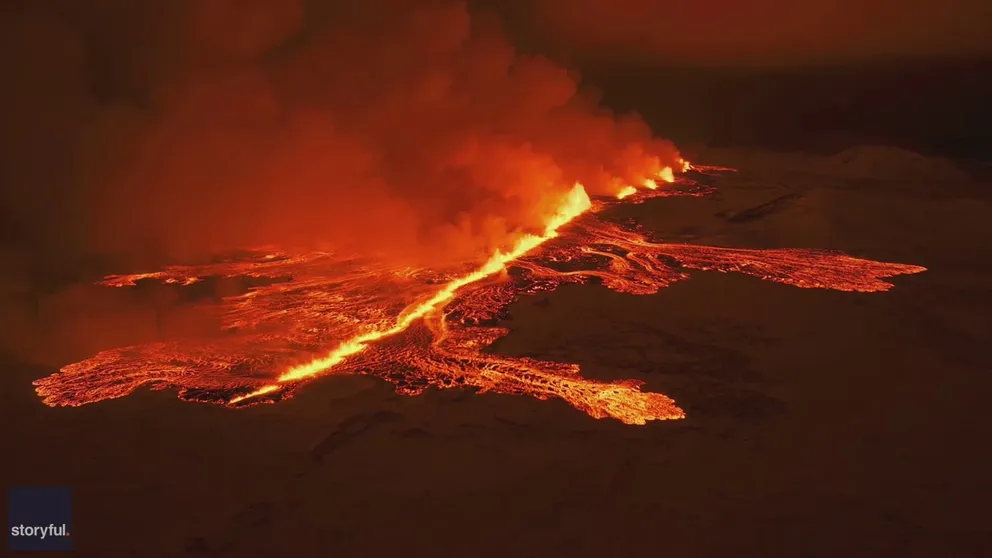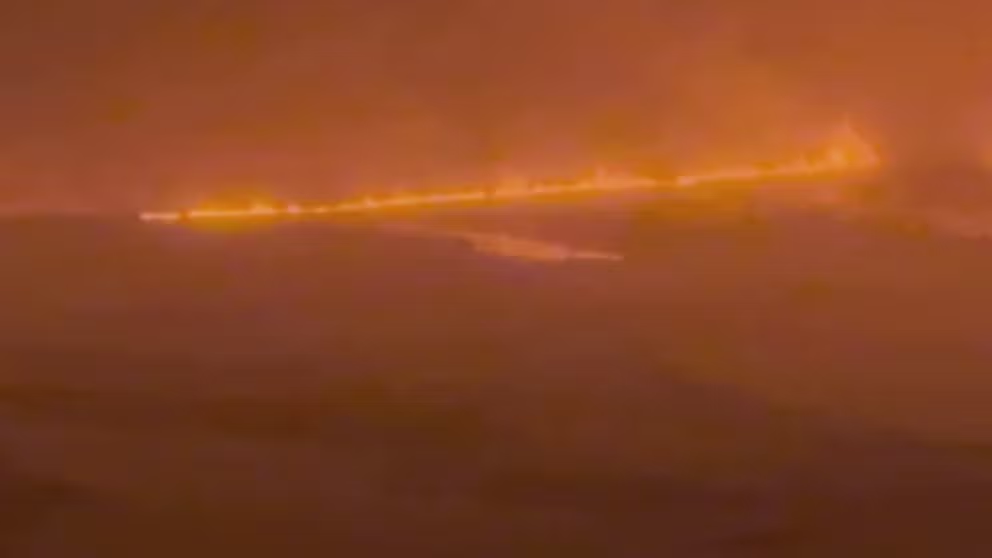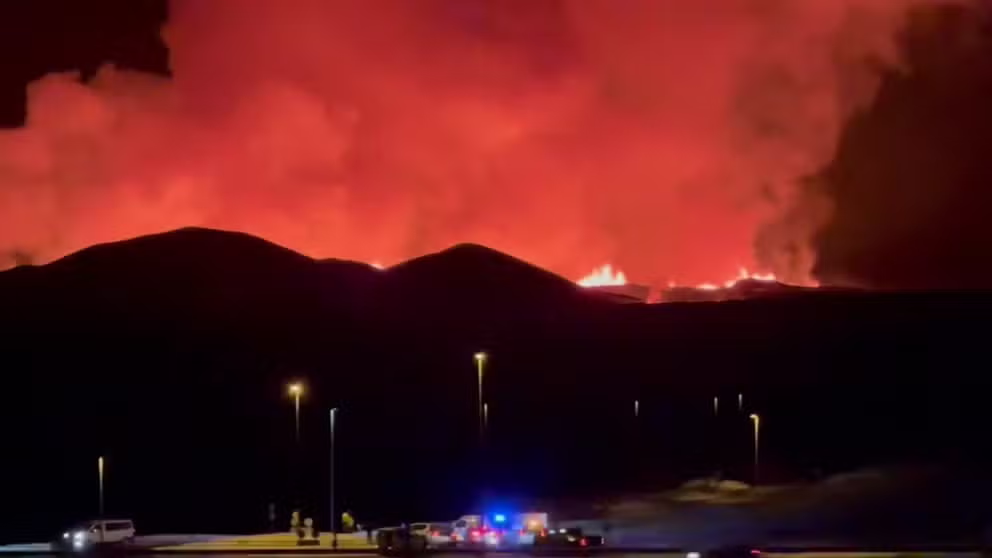Iceland's famed Blue Lagoon reopens despite continued concerns of 4th volcanic eruption since December
The Icelandic Meteorological Office (IMO) released a new hazard risk assessment map Sunday, which showed that the probability of an eruption in or around Grindavík has decreased, but officials warned that there is still a considerable risk of a new volcanic eruption in the area in the coming days.
Watch: Drone video shows lava shooting from volcanic fissure in Iceland
Dramatic video shows lava shooting from a long fissure north of Grindavik, Iceland, late Monday night after a volcano erupted in the area. (Video from December 2023)
GRINDAVIK, Iceland – Residents of the evacuated seaside town of Grindavík in Iceland continue to hold their breath in anticipation of a possible volcanic eruption in the area after officials said magma has once again accumulated underground.
The Icelandic Meteorological Office (IMO) released a new hazard risk assessment map Sunday, which showed that the probability of an eruption in or around Grindavík has decreased, but officials warned that there is still a considerable risk of a new volcanic eruption in the area in the coming days.
WHAT HAPPENS BEFORE A VOLCANO ERUPTS?
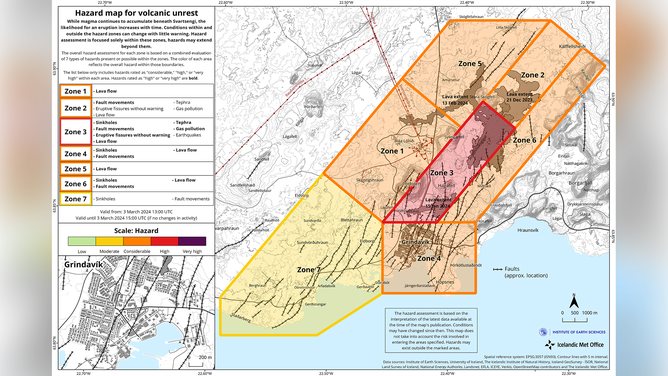
This graphic shows the updated volcanic hazard risk assessment on March 3, 2024.
(Icelandic Metrological Office)
This latest development comes after the IMO warned on Saturday that a fissure eruption was likely due to an intense swarm of earthquakes that began to shake the region.
The IMO said the earthquake activity began around 4 p.m. local time (11 a.m. EST) Saturday due to magma intrusion in the area and thus warned people that a new eruption was likely.
But about two hours later, the IMO said earthquake activity began to wane significantly and then ceased around 8 p.m. local time (3 p.m. EST).
Watch: Airline passenger gets bird's-eye view of Iceland volcanic eruption
A tourist on a flight arriving at Iceland's Keflavik airport captured dramatic video of a volcano eruption that began near the town of Grindavik. (Video from December 2023)
The IMO stressed, however, that the decrease in seismic activity didn’t necessarily mean the threat of a volcanic eruption was over.
"Data indicates that yesterday’s magma intrusion has stopped by Mt. Hagafell," the IMO said in a translated update on its website. "The likelihood of magma ascending in relation to this magma intrusion has decreased, but the area continues to be closely monitored for this possibility."
If the volcano were to erupt again, the IMO said it could occur with as little as a 30-minute warning.
CAN ONE VOLCANO'S ERUPTION TRIGGER AN ERUPTION AT ANOTHER VOLCANO?
Iceland’s Blue Lagoon reopens
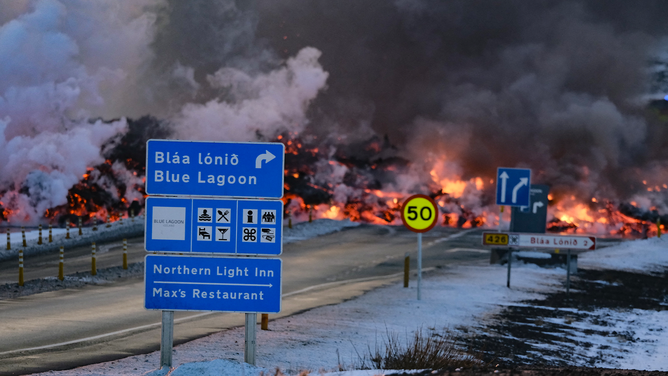
Molten lava is seen overflowing the road leading to the famous tourist destination "Blue Lagoon" near Grindavik, western Iceland on February 8, 2023. A volcanic eruption started on the Reykjanes peninsula in southwestern Iceland on Thursday, the third to hit the area since December, authorities said. (Photo by Kristinn Magnusson / AFP) / Iceland OUT (Photo by KRISTINN MAGNUSSON/AFP via Getty Images)
(Getty Images)
Iceland’s popular tourist destination Blue Lagoon was forced to evacuate on Saturday when the seismic activity began to ramp up and fears of an imminent eruption quickly grew.
Blue Lagoon was closed and evacuated several times over the past few months after earthquakes and volcanic eruptions sent lava close to the area.
Blue Lagoon said the decision to close the facility was made after seismic activity in the region, and the situation would be reassessed.
On Monday, the decision was made to reopen the facility and welcome back guests and staff.
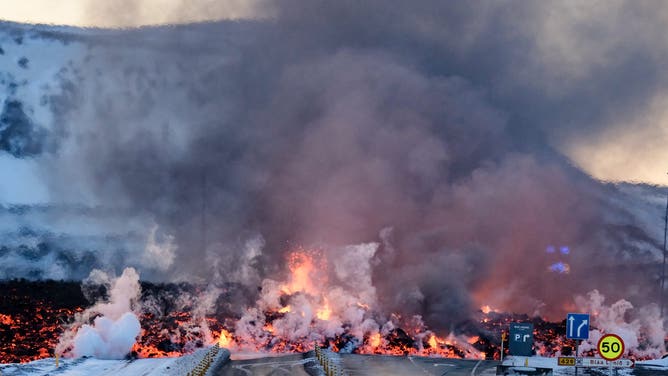
FILE - Molten lava is seen overflowing the road leading to the famous tourist destination "Blue Lagoon" near Grindavik, western Iceland on February 8, 2023. A volcanic eruption started on the Reykjanes peninsula in southwestern Iceland on Thursday, the third to hit the area since December, authorities said. (Photo by Kristinn Magnusson / AFP) / Iceland OUT (Photo by KRISTINN MAGNUSSON/AFP via Getty Images)
(Getty Images)
This reopening is a collaborative effort with local authorities, ensuring ongoing safety in light of recent seismic events," Blue Lagoon said in a statement on its website. "We wish to inform guests that our operational units are located within an area at risk due to seismic activity as identified by the Icelandic Meteorological Office."
Blue Lagoon went on to say that because the region continues to be threatened by possible earthquakes and volcanic activity, "appropriate actions will be taken" if conditions warrant.
"Experts continue to closely monitor the area and the ongoing developments of seismic activity through round-the-clock, real-time analysis," Blue Lagoon said in the statement. "Our operations, as always, follow the latest safety guidelines and recommendations of the authorities at any given time."
WHAT ARE THE 4 CLASSIC TYPES OF VOLCANOES?
Watch: Iceland volcano erupts for third time since December
A volcano in Iceland that led to the evacuation of the small seaside town of Grindavík at the end of 2023 has erupted for the third time since December. (Video from February 2024)
If an eruption were to occur, it would be the fourth eruption since the end of 2023, with the first occurring on Dec. 18, the second on Jan. 14 and the third on Feb. 8.
Grindavík residents have been evacuated several times since the activity started late last year.
No injuries have been reported from any of the eruptions, but lava flows destroyed some homes during the eruption on Jan. 14.
